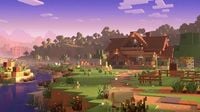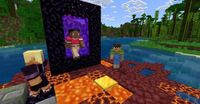In a significant shift for its player base, Minecraft has officially ended support for virtual and mixed reality gameplay with the latest update to its Bedrock Edition. This change, confirmed in the patch notes for version 1.21.80, follows a previous announcement from developer Mojang in October 2024, indicating that support for VR platforms would cease by March 2025. Players who enjoyed immersing themselves in the blocky world of Minecraft through VR headsets have now seen their options dramatically reduced.
Released in 2011 by Mojang Studios, Minecraft has grown to become the best-selling game of all time, boasting nearly 170 million monthly active players as of 2025. The game has been ported to almost every major gaming platform, but the recent update marks a notable departure from its previous offerings in the realm of virtual reality.
As part of the Bedrock Edition update, Mojang introduced Flat World presets, allowing players to build on a smooth, level landscape without the hindrance of uneven terrain. This feature aims to enhance the building experience, making it simpler for players to create their dream worlds. Alongside this, the update included a variety of bug fixes, including improvements to audio and block mechanics, ensuring a more seamless gameplay experience overall.
However, the removal of VR support is a sore point for many fans. Previously, players could engage with the game through platforms like PlayStation VR and various PC VR headsets, including Oculus Rift. The end of this support was not entirely unexpected; Mojang had signaled its intentions last year, stating that their "ability to support VR/MR devices has come to an end, and will no longer be supported in updates after March of 2025." As a result, VR enthusiasts received a brief grace period, allowing them a few extra weeks of gameplay before the final cut.
For those who still wish to experience Minecraft in virtual reality, unofficial mods like Vivecraft offer alternatives. Vivecraft allows players to enjoy Minecraft on SteamVR, Oculus, and other VR platforms, but it requires the Java version of the game. It supports various multiplayer options, including LAN and server play, albeit without cross-play capabilities with the Bedrock Edition.
Despite the disappointment surrounding the cessation of official VR support, some casual players were unaware that Minecraft had previously been available in virtual reality. Comments from players indicate that while they might not have experienced it firsthand, the idea of exploring the vast landscapes of Minecraft in VR sounds intriguing.
The decision to drop VR support has sparked discussions within the gaming community. While many recognize the potential benefits of VR, the reality is that not every player is equipped or interested in the technology. As such, Mojang's choice reflects a broader trend in the gaming industry, where developers must weigh the costs and benefits of supporting emerging technologies against their existing player base.
As of now, Minecraft remains playable on multiple consoles and platforms, but VR is no longer one of them. The removal of this feature is seen by some as a step back for a game that has consistently pushed the boundaries of creativity and innovation. The once-promising integration of VR technology into Minecraft has now become another chapter in the game's evolving narrative.
Looking back, the early demos of Minecraft in VR, such as the impressive showcase for HoloLens, left many players hopeful for a fully immersive experience. However, as the landscape of gaming continues to shift, players may need to adapt to the new reality of Minecraft without VR.
In addition to the changes in VR support, the recent updates to the Java Edition of Minecraft have also brought changes to crafting recipes and potion mechanics, keeping the game fresh and engaging for its dedicated fanbase. The snapshot update for April 2025 introduced tweaks to crafting recipes for items like dried ghasts and leads, further enhancing gameplay.
While the end of official VR support is a disappointing development for some, Mojang's commitment to improving the core gameplay experience remains evident. The introduction of Flat World presets and ongoing bug fixes demonstrate the developer's focus on creating a smoother and more enjoyable environment for players.
As Minecraft continues to thrive with its massive player base, the community will undoubtedly find ways to adapt and evolve alongside the game. Whether through unofficial mods or new updates, the spirit of creativity that has defined Minecraft since its inception will likely persist, even as the platform shifts away from virtual reality.
In the grand scheme of gaming, the decision to remove VR support may not be as catastrophic as it seems. While it marks the end of a chapter for Minecraft, it also opens the door for new possibilities and innovations within the game. As players continue to build, explore, and create, the essence of Minecraft will endure, reminding everyone of the joy and creativity that the game has brought to millions.


